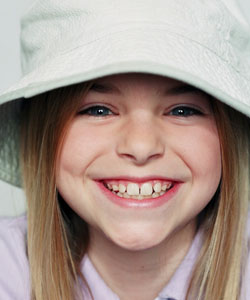Types of Appliances

To successfully complete the orthodontic treatment plan, patients must work together with the orthodontist. The teeth and jaws can only move toward their corrected positions if the patient consistently wears the elastics (rubber bands), headgear, or other appliances as prescribed.
The following paragraphs describe the types of appliances that may be used during your treatment.
Elastics (Rubber Bands)
Wearing elastics (rubber bands) improves the fit of your upper and lower teeth. Wear rubber bands as instructed because the rubber bands work far more efficiently if they are worn as prescribed. Forgetting or neglecting to wear your rubber bands, even for one day, will allow the teeth to drift back to their previous positions. This will extend your treatment time significantly.
ForsusŪ Appliance
The Forsus is designed to work like permanent rubber bands. It is used to improve the relationship between upper and lower teeth by encouraging the lower jaw forward and the upper molars backward.
Headgear
Headgear is used to treat patients whose teeth are in an "overbite," (with the uppers forward of the lowers), a "deep bite" (where the upper teeth cover the lower teeth), or an "open bite" (when the front teeth do not touch when you bite). Headgear gently "pulls" on your teeth and restricts further forward growth of your upper teeth and jaw.
Lingual Arch
A lingual arch is placed on lower molars to keep them from shifting when teeth are lost or when forces are used during orthodontic treatment. A wire bar connects the two sides of the lingual arch and rests comfortably below the teeth.
Palatal Expander
The palatal expander "expands" (widens) your upper jaw by putting gentle pressure on your upper molars each time an adjustment is made. Your orthodontist will instruct you about when and how to adjust your expander. When you achieve the desired expansion, you will wear the appliance for several months to solidify the expansion and to prevent regression.
Retainers
Retainers hold your teeth in their new, corrected positions after your braces are removed. Your orthodontist will instruct you on how to care for your retainer and about the duration of the wear. Wearing your retainer as directed is crucial to prevent relapse of your treatment.
Click here for more information on how to care for your retainer.
Separators or Spacers
Separators are little rubber doughnuts that may be placed between your teeth to push them apart so that orthodontic bands may be placed during your next appointment. The separators will be removed before we place the bands. Separators can become dislodged with sticky foods or with toothpicks and floss. If they do become dislodged, please call the office so that they can be replaced before the next appointment.
Temporary Anchorage Device (TAD, or Mini-Implant)
A TAD, or mini-implant, is a small screw-like device that is temporarily fixed to the bone to help support the movement of teeth and can eliminate the need for headgear, elastics, and in some cases, even jaw surgery. These devices are on the cutting edge of orthodontic treatment technology, and are relatively painless to place and remove.
Trans-Palatal Arch (TPA)
A trans-palatal arch is placed on the upper molars and is similar to a lingual arch. Palatal arches are used in for a variety of reasons including after palatal expansion to prevent relapse. Sometimes a small, smooth acrylic button is placed on the arch to prevent the upper teeth from shifting forward during treatment.




